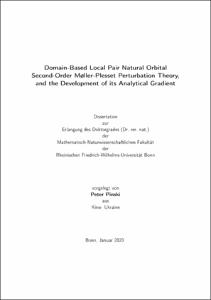Domain-Based Local Pair Natural Orbital Second-Order Møller-Plesset Perturbation Theory, and the Development of its Analytical Gradient

Domain-Based Local Pair Natural Orbital Second-Order Møller-Plesset Perturbation Theory, and the Development of its Analytical Gradient

| dc.contributor.advisor | Neese, Frank | |
| dc.contributor.author | Pinski, Peter | |
| dc.date.accessioned | 2020-08-18T12:01:25Z | |
| dc.date.available | 2020-08-18T12:01:25Z | |
| dc.date.issued | 18.08.2020 | |
| dc.identifier.uri | https://hdl.handle.net/20.500.11811/8530 | |
| dc.description.abstract | Dynamic electron correlation methods are known to have a computational cost that scales with a high power of the system size: for example, O(N5) for second-order Møller-Plesset perturbation theory (MP2), and O(N7) for coupled cluster with single, double and perturbative triple excitations (CCSD(T)). Domain-based local pair natural orbital (DLPNO) methods reduce this scaling, while maintaining a modest prefactor, using several approximations: most critically by expanding the virtual space in truncated sets of pair natural orbitals (PNOs), which are combined with the domain approximation and orbital pair screening.
The first part of this work consists of the implementation of MP2 in the DLPNO framework, drawing closely upon the previously existing DLPNO-CCSD method. Several improvements were introduced in the process: (1) The transformation routine for one-external three-index integrals was replaced with a formally linear scaling algorithm, which treats sparsity relationships in a systematic framework. (2) A new domain selection criterion was introduced based on the differential overlap integral between occupied localised orbitals and redundant projected atomic orbitals. (3) An improved, more accurate procedure to screen orbital pairs was developed. DLPNO-MP2 was confirmed to reproduce energy differences computed with the canonical resolution of the identity (RI-)MP2 method to within chemical accuracy, and its performance was demonstrated in large-scale calculations. A simple unrestricted variant of DLPNO-MP2 was implemented for open-shell calculations. The second and major part of this thesis is the development of the analytical gradient for the closed-shell DLPNO-MP2 method. Importantly, the exact derivative of the entire energy was taken. Mathematical contributions to account for the relaxation of PNOs were described for the first time in the context of local correlation methods. Calculations of electric field gradients with exact and approximate derivatives emphasise the importance of the individual contributions. Additionally, a procedure was introduced to circumvent singularities in the coupled-perturbed localisation equations, which are caused by continuously degenerate localised orbitals. Extensively testing the DLPNO-MP2 gradient in geometry optimisations showed that it reproduces covalent RI-MP2 bond lengths to well within 0.1 pm. Errors in interatomic distances between non-covalently interacting system parts do not exceed 1 % with default thresholds and 0.3 % with tight thresholds. The DLPNO-MP2 gradient becomes substantially more efficient than the RI-MP2 gradient beyond ca. 70 atoms, while a similar computational effort is incurred in smaller applications. Among the most demanding calculations demonstrated in this work were the geometry optimisation of a host-guest complex containing 205 atoms and more than 4000 basis functions, and a single-point gradient calculation for crambin with 644 atoms and over 12 000 basis functions. Spin-component scaling and double-hybrid density functionals are supported by the implementation. | en |
| dc.language.iso | eng | |
| dc.rights | In Copyright | |
| dc.rights.uri | http://rightsstatements.org/vocab/InC/1.0/ | |
| dc.subject | Quantenchemie | |
| dc.subject | elektronische Struktur | |
| dc.subject | Elektronenkorrelation | |
| dc.subject | lokale Näherung | |
| dc.subject | paarspezifische natürliche Orbitale | |
| dc.subject | Störungstheorie | |
| dc.subject | Ableitung | |
| dc.subject | Gradient | |
| dc.subject | Geometrieoptimierung | |
| dc.subject | quantum chemistry | |
| dc.subject | electronic structure | |
| dc.subject | electron correlation | |
| dc.subject | local approximation | |
| dc.subject | pair natural orbitals | |
| dc.subject | perturbation theory | |
| dc.subject | derivative | |
| dc.subject | gradient | |
| dc.subject | geometry optimisation | |
| dc.subject.ddc | 540 Chemie | |
| dc.title | Domain-Based Local Pair Natural Orbital Second-Order Møller-Plesset Perturbation Theory, and the Development of its Analytical Gradient | |
| dc.type | Dissertation oder Habilitation | |
| dc.publisher.name | Universitäts- und Landesbibliothek Bonn | |
| dc.publisher.location | Bonn | |
| dc.rights.accessRights | openAccess | |
| dc.identifier.urn | https://nbn-resolving.org/urn:nbn:de:hbz:5-59225 | |
| ulbbn.pubtype | Erstveröffentlichung | |
| ulbbnediss.affiliation.name | Rheinische Friedrich-Wilhelms-Universität Bonn | |
| ulbbnediss.affiliation.location | Bonn | |
| ulbbnediss.thesis.level | Dissertation | |
| ulbbnediss.dissID | 5922 | |
| ulbbnediss.date.accepted | 18.06.2020 | |
| ulbbnediss.fakultaet | Mathematisch-Naturwissenschaftliche Fakultät | |
| dc.contributor.coReferee | Grimme, Stefan |
Dateien zu dieser Ressource
Das Dokument erscheint in:
-
E-Dissertationen (4434)




